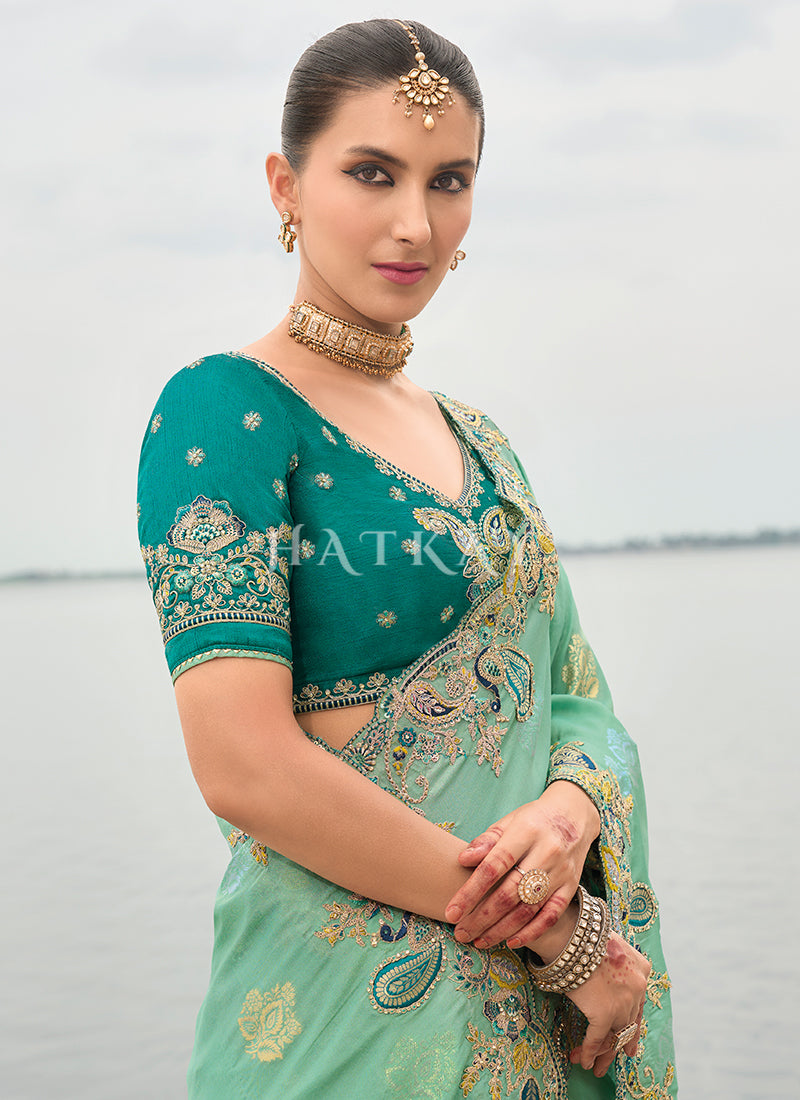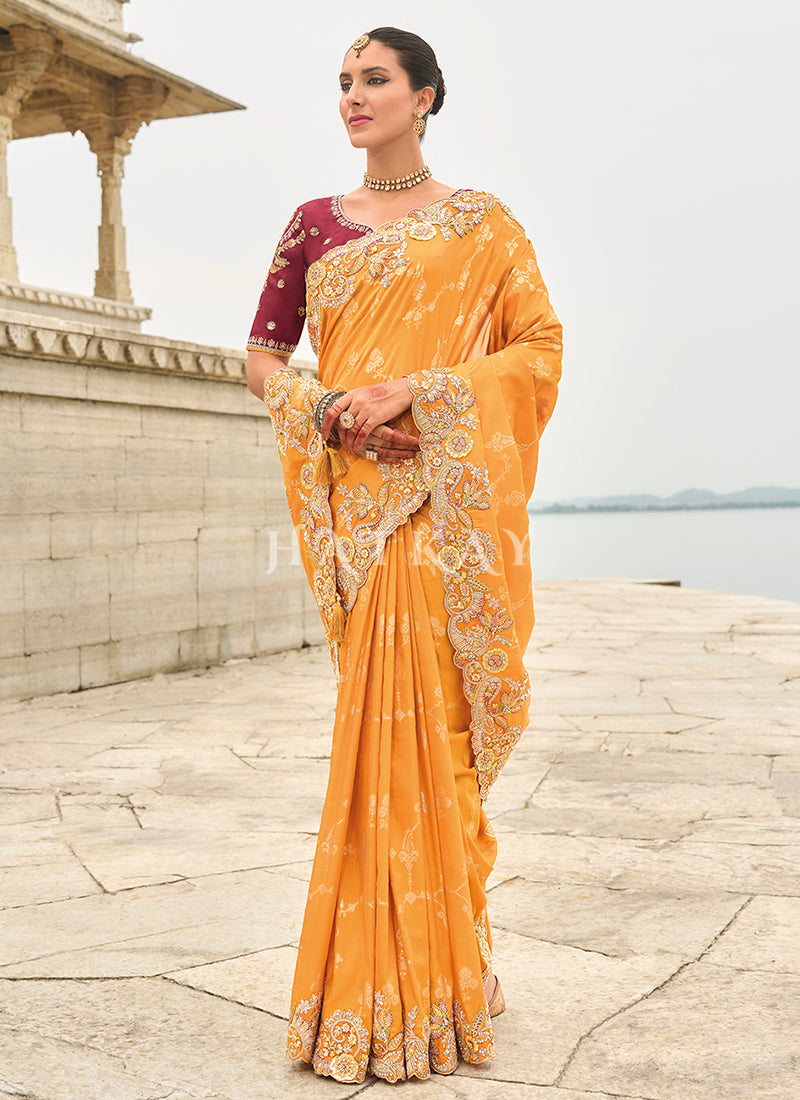The saree, a traditional attire worn by women across India and South Asia, is one of the most iconic and enduring garments in the world. Known for its elegance, versatility, and cultural significance, the saree is a long piece of fabric, typically ranging from five to nine yards, draped around the body in various styles. It is often paired with a fitted blouse and a petticoat, enhancing its beauty and functionality. More than just a piece of clothing, the saree is a symbol of heritage, femininity, and timeless fashion.
The History of the Saree
The saree has a history that spans thousands of years. Its origins can be traced back to the Indus Valley Civilization (2800–1800 BCE), where women are believed to have worn long, draped garments resembling the saree. Ancient sculptures and paintings from this period depict women clad in saree-like attire, highlighting its deep cultural roots.
Over the centuries, the saree evolved, influenced by different dynasties, trade, and regional artistry. Some key historical influences include:
-
The Vedic Period (1500–500 BCE): Texts from this period reference women wearing unstitched draped garments, emphasizing the tradition of saree-wearing even in early times.
-
The Maurya and Gupta Empires (4th Century BCE–6th Century CE): Sarees in this era became more ornate, with the introduction of silk and cotton fabrics, and decorative motifs inspired by nature and mythology.
-
The Mughal Era (16th–18th Century CE): This period brought luxurious silk and brocade sarees, intricate embroidery, and heavy embellishments, particularly in the northern regions of India.
-
The British Colonial Period (19th–20th Century CE): Sarees adapted to European influences, with new materials like chiffon and georgette becoming popular. Women also began draping sarees in a more structured manner, influenced by Victorian fashion.
Today, the saree continues to evolve while preserving its traditional charm, with modern adaptations and innovative draping styles becoming widely accepted.
Regional Variations of the Saree
India is home to a diverse range of sarees, each region offering its unique take on this timeless attire. Some of the most notable regional sarees include:
-
Banarasi Saree (Uttar Pradesh): Famous for its rich silk fabric and intricate zari work, this saree is a staple for Indian brides.
-
Kanjeevaram Saree (Tamil Nadu): Made from pure mulberry silk, this saree is known for its temple motifs and vibrant colors.
-
Paithani Saree (Maharashtra): Characterized by peacock motifs and gold thread work, it is a symbol of Marathi culture.
-
Bandhani Saree (Gujarat and Rajasthan): A tie-dye saree known for its vibrant hues and intricate patterns.
-
Sambalpuri Saree (Odisha): Handwoven and featuring traditional Ikat designs, this saree is both elegant and comfortable.
-
Muga Silk Saree (Assam): Made from a rare silk variety found only in Assam, this saree has a distinctive golden sheen.
-
Baluchari Saree (West Bengal): Features mythological narratives woven into its design, making it a piece of wearable art.
Types of Sarees for Different Occasions
Sarees are worn for a variety of occasions, each style catering to a specific event:
-
Bridal Sarees: Banarasi, Kanjeevaram, and Paithani sarees are the preferred choice for brides due to their rich fabric and intricate craftsmanship.
-
Festive Sarees: Bandhani, Patola, and Chanderi sarees are popular during Diwali, Navratri, and other festivals.
-
Office and Formal Wear Sarees: Linen, Khadi, and cotton sarees offer a comfortable yet sophisticated look for work settings.
-
Party Wear Sarees: Designer sarees made of georgette, chiffon, and organza with embroidery and sequins add glamour to special occasions.
-
Casual Sarees: Lightweight cotton and printed sarees are perfect for everyday wear, providing both comfort and elegance.
Modern Trends in Sarees
Fashion designers have continuously reinvented the saree, introducing new trends to appeal to contemporary tastes:
-
Pre-Draped Sarees: Ready-to-wear sarees that eliminate the hassle of traditional draping.
-
Fusion Sarees: A blend of traditional sarees with gowns, dhotis, or lehengas for a unique twist.
-
Pastel Hues and Minimalist Designs: Softer colors and subtle embroidery are trending over traditional bright shades.
-
Belted Sarees: Adding a stylish belt enhances the saree’s silhouette.
-
Sarees with Capes: Modern adaptations that replace the conventional pallu with a flowing cape.
-
Sustainable and Handloom Sarees: The growing demand for eco-friendly fashion has revived interest in handwoven and organic sarees.
Styling Tips for Sarees
To achieve the perfect saree look, styling plays a crucial role. Here are some tips to enhance your saree ensemble:
-
Jewelry: Temple jewelry, Kundan, Polki, and pearls complement traditional sarees beautifully.
-
Blouses: Experimenting with different blouse styles like halter necks, boat necks, or off-shoulders can add a modern touch.
-
Footwear: Traditional mojaris, embellished sandals, or elegant heels complete the ensemble.
-
Hairstyles: Braided buns adorned with flowers or loose curls complement the saree beautifully.
-
Draping Styles: Trying different draping techniques like Nivi, Bengali, or Gujarati drape can bring versatility to the look.
Conclusion
The saree is more than just an outfit; it is an expression of heritage, beauty, and tradition. It has withstood the test of time, adapting to different eras while maintaining its elegance and grace. Whether worn for a wedding, festival, or casual outing, the saree continues to be a cherished garment, blending culture with modern sensibilities. Its adaptability, combined with its deep-rooted historical and cultural significance, ensures that the saree remains a timeless and beloved attire for generations to come.













